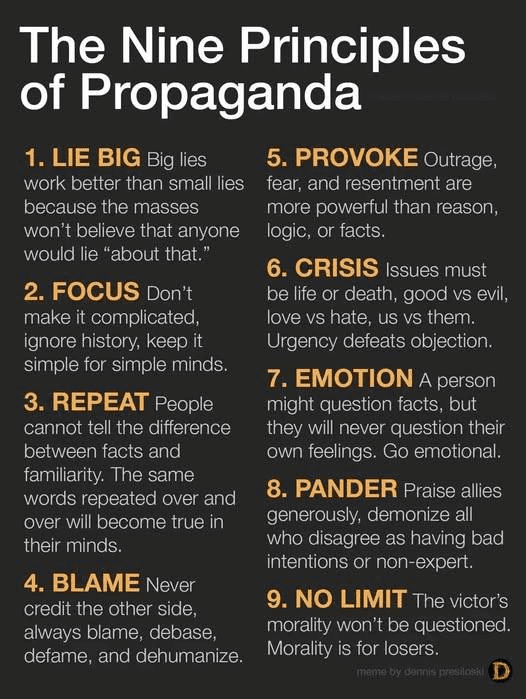The Destructive Game: Propaganda

A Facebook friend posted this graphic. She didn’t know its author. Its author is at the bottom of the graphic. He has a blog.
The list that Dennis Presiloski shared differs from the one that I have been sharing. The one that I found, in 2017, came from Jonathan G. Leonard at University of Vermont. It names specific techniques, with examples.
From 2017:
To recognize propaganda, look for one or more of these techniques.
- Name calling and stereotyping.
- Virtue words. Examples: “Natural”, “Democratic”, “Organic”, “Scientific”, “Ecological”, “Sustainable”.
- Deification. This is when an idea is made to appear holy, sacred, or very special and therefore above all law. Any alternative or opposite points of view are thereby given the appearance of treason or blasphemy. Examples: “God-given right to…”, “Mother Earth”, “Gia”.
- Transfer. When a symbol that carries respect, authority that is used along with an idea or argument to make it look more acceptable. Examples: American Flag, University Seal, Medical Association Symbol (or something that looks like it). This method is also called guilt or virtue by association.
- Testimonial. When some respected celebrity (or alternatively someone generally hated) claims that an idea or product is good (or bad). This technique is used to convince us without examining the facts more carefully.
- Plain folks. This is a way that a speaker convinces an audience that an idea is good because they are the same ideas of the vast majority of people like yourself. Uses, words like everyone, always.
- Bandwagon. The speaker tries to convince us to accept their point of view or else we will miss out on something really good. “Act Now!”.
- Artificial dichotomy. This is when someone tries to claim there are only two sides to an issue and that both sides must have equal presentation in order to be evaluated. The two sides do not have equal validity, so the comparison is misleading.
- Hot potato. Asking a leading question to embarrass the opponent. “When will you pay the taxes you owe?” The fact that it may be utterly untrue is irrelevant, because it still brings controversy to the opponent.
- Stalling or ignoring the question. This technique is used to play for more time or to avoid answering a pointed question. Examples: “More research is needed…”, “A fact-finding committee is working on this issue
- Least of the evils. This is used to justify an otherwise unpleasant or unpopular point of view. Example: ‘”War is hell but appeasement leads to worse disasters”.
- Scapegoating. This deflects scrutiny away from the issues. It transfers blame to one person or group of people without investigating the complexities of the issue. It combines stereotyping with guilt-by-association.
- Cause and effect mismatch. Oversimplification of a cause or effect can be misleading. Example: It is misleading to say just one of the following: “Tuberculosis is caused by bacteria”, “Tuberculosis is caused by un-regulated capitalism that creates poor working conditions”, “Tuberculosis is caused by a lack of effective antibiotics”.
- Distortion of data. Misuse of statistics. This technique is used to convince the audience by using selected information and not presenting the complete story. I have written extensively on how this one is used in real estate!
- Weak inference. Conclusions that do not follow from the evidence given. For example: Most rich folks vote Republican, therefore most people who vote Republican are rich.
- Faulty analogy. This is when a comparison is carried too far. When a conclusion is based on something that is an extreme example (called the slippery slope argument.) Example: smoking pot will lead to heroin addiction.
- Using fear. People will act to avoid something they fear.
- Personal attack or deflection. The argument is answered with criticism of the person speaking or style of the comment instead of the topic.
- Tu quoque attack. Accuse to opponent of using a propaganda technique instead of addressing the content of the comment.
- Preemptive Framing. Make a false statement about the topic as part of the introduction of the topic. Example: Since all pot smokers go on to take other drugs…”
- Come up with another event that will draw media attention away from the topic you want to avoid. Example: if a company gets bad press, they may throw a charity event, or a big sale, or flood their social media sites with positive reviews.
Adapted from this Source